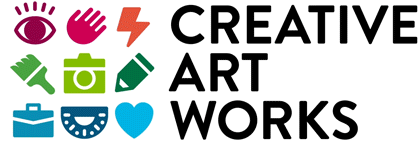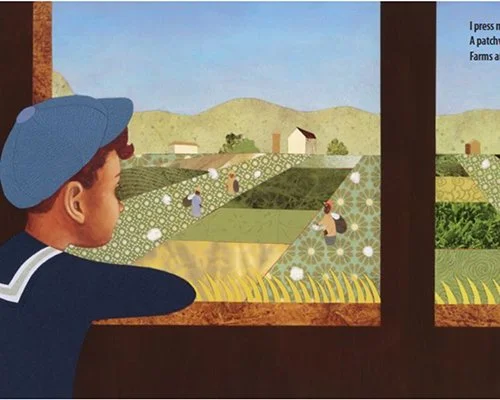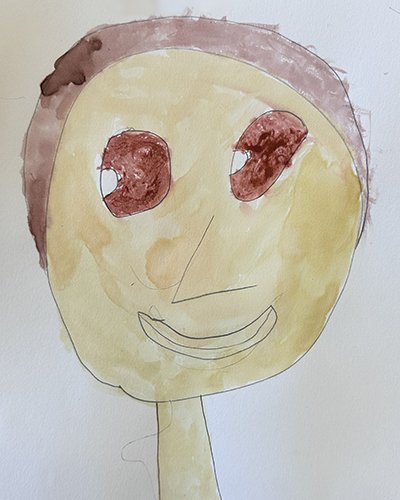Dive in and Try It
“To listen and understand and enjoy a story is a wonderful experience in itself, but to be able to immerse oneself further into a story by experimenting with and discovering the art that connects to the words on the page is really special.”
Creative Art Works has returned to PS 153 in Hamilton Heights with an in-school literacy-based art curriculum. Each project invites first-grade students to respond to a classic children’s book. Students are then given the chance to explore materials and create art that is directly related to the illustration style of the book and is also informed by the themes of the text. For example, one project was inspired by My Hands Sing the Blues, written by Jeanne Walker. The book is about the life and creativity of Harlem renaissance artist Romare Bearden and is wonderfully illustrated by Elizabeth Zunon using photo collages in Bearden’s signature style. Since Bearden’s art often had a strong sense of place, students were encouraged to make their own photo collages about place.
Other readings in the program include the classic Harold and the Purple Crayon, written and illustrated by Crocket Johnson; the Caldecott-winning Frederick, written and illustrated by Leo Lionni, and the the unapologetically silly I Like Myself, written by Karen Beaumont and illustrated by David Catrow.
We invite you to enjoy some selected works by our young artists in the following galleries.
Detail from My Hands Sing the Blues
Place collages inspired by My Hands Sing the Blues, written by Jeanne Walker Harvey and illustrated by Elizabeth Zunon
My Hands Sing the Blues is a book about the life and artistry of Harlem Renaissance painter Romare Bearden. The book itself is illustrated with collages inspired by Bearden’s signature style. CAW Teaching Artist Maham Khwaja said, “For this activity, I wanted students to create a collage of a place. Students were asked to explore different patterns and textures, experimenting with placement and seeing how they would like the pieces to all fit together."
Harold draws an apple tree
Line drawings inspired by Harold and the Purple Crayon, written and illustrated by Crocket Johnson
Harold and the Purple Crayon is about exploration, discovery, and problem solving. The titular character draws himself in and out of a variety of adventures using nothing but a big purple crayon. The book uses minimalist illustrations to encourage children to exercise the power of their imaginations. Maham encouraged her students to take healthy risks and make several line drawings of their own.
Detail from Frederick
Torn-paper collages inspired by Frederick, written and illustrated by Leo Lionni
Leo Lionni illustrated his Caldecott-winning children’s book Frederick with nothing but torn paper and glue. Maham asked her students to experiment with their own torn-paper collages, and they dove in with enthusiasm.
Detail from I Like Myself
Self portraits inspired by I Like Myself, written by Karen Beaumont and illustrated by David Catrow
I Like Myself! is about radical self love. The main character likes herself even on bad hair days or when she is being silly or scared. Students were asked to create their own self portraits using watercolors in response to this book. The comically energetic style of Cartow’s illustrations encourages students not to worry too much about rendering an accurate likeness in their own work and to instead focus on being expressive.
Integrating art-making into the language arts curriculum creates educational synergy. The process of manipulating safety scissors, paint brushes, and glue sticks builds fine motor skills, engages executive functions such as time management, and exercise problem-solving skills. The act of responding to literature through art improves comprehension and long-term retention, builds vocabulary, and engages different learning modalities. It’s also been correlated with more consistent attendance, better test scores, and increased graduation rates.
“Students are consistently joyful and excited to participate and experiment with new techniques. Each activity is also a challenging, new art technique for the students and they are more than happy to dive in and try it. Being able to both observe as well as create the type of art from a book is a really rewarding practice for students, because it opens a door into a dynamic and active way of learning.”
This program was made possible, in part, by the West Harlem Development Corporation, and by public funds from the New York State Council on the Arts with the support of the Office of the Governor and the New York State Legislature.
















































